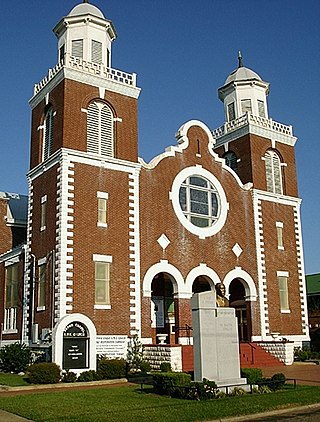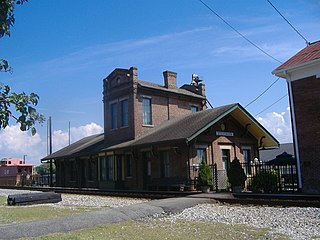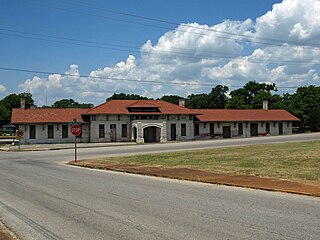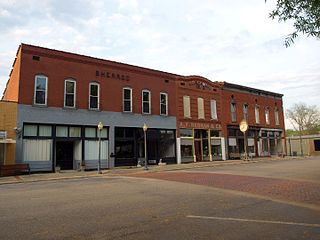
St. Stephens is an unincorporated census-designated place in Washington County, Alabama, United States. Its population is 580. Located near the Tombigbee River in the southwestern part of the state and 67 miles north of Mobile, it is composed of two distinct sites: Old St. Stephens and New St. Stephens. The Old St. Stephens site lies directly on the river and is no longer inhabited. It was the territorial capital of the Alabama Territory. Now encompassed by the Old St. Stephens Historical Park, it is listed on the National Register of Historic Places.

Snead State Community College is a public community college in Boaz, Alabama. It began as a private seminary in 1898 and became part of the Alabama Community College System in 1967. Snead awards associate degrees in 79 programs and certificates in 24 programs.

The Bessemer Hall of History is a museum located in, and devoted to the history of, the city of Bessemer, Alabama.

The Huntsville Depot located on the Norfolk Southern Railway line in downtown Huntsville is the oldest surviving railroad depot in Alabama and one of the oldest in the United States. Completed in 1860, the depot served as eastern division headquarters for the Memphis and Charleston Railroad. It is listed on both the Alabama Register of Landmarks and Heritage and National Register of Historic Places.

Montgomery Union Station and Trainshed is a historic former train station in Montgomery, Alabama. Built in 1898 by the Louisville and Nashville Railroad, rail service to the station ended in 1979 and it has since been adapted for use by the Montgomery Area Visitor Center and commercial tenants. It was added to the National Register of Historic Places in 1973 and became a National Historic Landmark in 1976.

Gulfport station is a closed Amtrak intercity train station in Gulfport, Mississippi, United States. Gulfport is a former union station that served the Louisville and Nashville Railroad and Gulf and Ship Island Railroad.
The Alabama Register of Landmarks and Heritage, commonly referred to as the Alabama Register, is an official listing of buildings, sites, structures, objects, and districts deemed worthy of preservation in the U.S. state of Alabama. These properties, which may be of national, state, and local significance, are designated by the Alabama Historical Commission. The designation is honorary and carries no direct restrictions or incentives. The register includes properties such as cemeteries, churches, moved properties, reconstructed properties, and properties at least 40 years old which may not normally qualify for listing in the National Register of Historic Places. There are approximately 1421 properties and districts listed on the Alabama Register. Of these, approximately 196 are also listed on the National Register of Historic Places and 5 are designated as National Historic Landmarks.

Brown Chapel A.M.E. Church is a church at 410 Martin Luther King Jr. Boulevard in Selma, Alabama, United States. This church was a starting point for the Selma to Montgomery marches in 1965 and, as the meeting place and offices of the Southern Christian Leadership Conference (SCLC) during the Selma Movement, played a major role in the events that led to the adoption of the Voting Rights Act of 1965. The nation's reaction to Selma's "Bloody Sunday" march is widely credited with making the passage of the Voting Rights Act politically viable in the United States Congress.

The Georgia State Railroad Museum is a museum in Savannah, Georgia located at a historic Central of Georgia Railway site. It includes parts of the Central of Georgia Railway: Savannah Shops and Terminal Facilities National Historic Landmark District. The complex is considered the most complete antebellum railroad complex in the United States. The museum, located at 655 Louisville Road, is part of a historic district included in the National Register of Historic Places.

Central of Georgia Depot and Trainshed is a former passenger depot and trainshed constructed in 1860 by the Central of Georgia Railway (CofG) before the outbreak of the American Civil War. This pair of buildings was declared a National Historic Landmark in 1976, a listing that was expanded in 1978 to the old Central of Georgia Railway Savannah Shops and Terminal Facilities.

Altwood is a historic plantation house located near Faunsdale, Alabama. It was built in 1836 by Richard H. Adams and began as a log dogtrot house. It was then expanded until it came to superficially resemble a Tidewater-type cottage. Brought to the early Alabama frontier by settlers from the Tidewater and Piedmont regions of Virginia, this vernacular house-type is usually a story-and-a-half in height, displays strict symmetry, and is characterized by prominent end chimneys flanking a steeply pitched longitudinal gable roof that is often pierced by dormer windows.
Southern Railway Depot, or variations such as Southern Railway Passenger Station or Passenger Depot, Southern Railway Freight Depot or Freight Office, may refer to any of numerous railway stations operated by the U.S.-based Southern Railway or stations operated by other Southern Railway companies.
This is a list of properties on the Alabama Register of Landmarks and Heritage, sorted alphabetically by county. This list contains all entries for Pickens County through Winston County, the other listings may be found here. The Alabama Register of Landmarks and Heritage is an official listing of buildings, sites, structures, objects, and districts deemed worthy of preservation in the U.S. state of Alabama.
This is a list of properties on the Alabama Register of Landmarks and Heritage, sorted alphabetically by county. This list contains all entries for Madison County through Perry County, the other listings may be found here. The Alabama Register of Landmarks and Heritage is an official listing of buildings, sites, structures, objects, and districts deemed worthy of preservation in the U.S. state of Alabama.

The Tankersley Rosenwald School, also known as the Tankersley Elementary School, is a historic American Craftsman-style school building in Hope Hull, Alabama, a suburb of Montgomery. This Rosenwald School building was built in 1922 to serve the local African American community. The money to build the school was provided, in part, by the Julius Rosenwald Fund. It was added to the Alabama Register of Landmarks and Heritage on June 26, 2003, and to the National Register of Historic Places as a part of The Rosenwald School Building Fund and Associated Buildings Multiple Property Submission on January 22, 2009.

The Stevenson Railroad Depot and Hotel station are a historic train station and hotel in Stevenson, Alabama. They were built circa 1872 as a joint project of the Memphis and Charleston Railroad and the Nashville and Chattanooga Railroad, whose lines converged in Stevenson. When the Memphis & Charleston was purchased by the Southern Railway in 1898, the Louisville and Nashville Railroad took sole control of the depot and operated it until 1976. It was converted into a history museum in 1982. Both buildings are brick with gable roofs and Italianate details. The depot has a central, second-story tower that was added in 1887. The three-story hotel had a lobby, dining room, and kitchen on the first floor and eight large guest rooms on the upper floors. The buildings were listed on the Alabama Register of Landmarks and Heritage in 1975 and the National Register of Historic Places in 1976.

The Southern Railway Depot is a historic building in Decatur, Alabama. The depot was built in 1904–05 along the Southern Railway line. Decatur had become a transportation hub of North Alabama by the 1870s, with its connections to the Tennessee River, the east–west Tuscumbia, Courtland and Decatur Railroad, and the north–south Louisville and Nashville Railroad.

The Courtland Historic District is a historic district in Courtland, Alabama. Courtland was founded in 1818 and incorporated the following year. Its location was chosen to be close to the Tennessee River to facilitate transportation, but also close to cotton plantations to the south. The town's founders envisioned becoming the county seat of the newly formed Lawrence County, but the title instead went to Moulton. Many of the earliest structures in Courtland were built of logs, and were later replaced with frame and brick buildings. Development plateaued by 1830, but received a slight bump from the Tuscumbia, Courtland and Decatur Railroad beginning in 1834. The oldest houses in the district date from this era, including the 1828 Federal-style John McMahon House and several I-houses.

The Alabama Midland Railway Depot is a historic train station in Ashford, Alabama. Ashford was founded in 1891 along the Alabama Midland Railway line between Montgomery and Bainbridge, Georgia. The depot was built the next year, and served as the commercial hub of the town. The Alabama Midland became part of the Plant System is 1894, which was taken over by the Atlantic Coast Line Railroad in 1901 and merged into the Seaboard Coast Line Railroad in 1967. Nearly all of the downtown area was destroyed in a fire in 1915, but the depot survived. The depot closed in 1978, and was renovated as an event space in 2005.



















